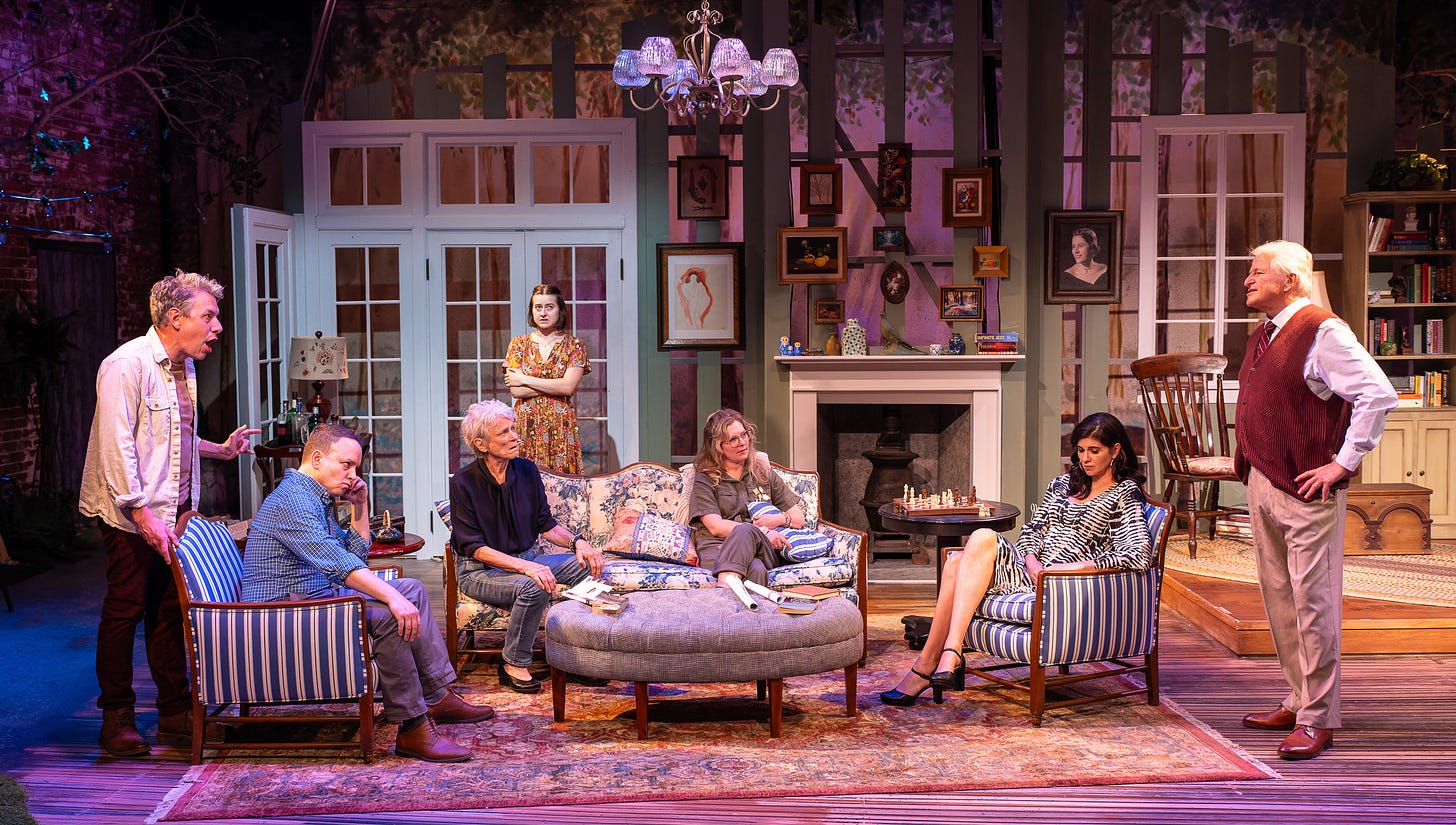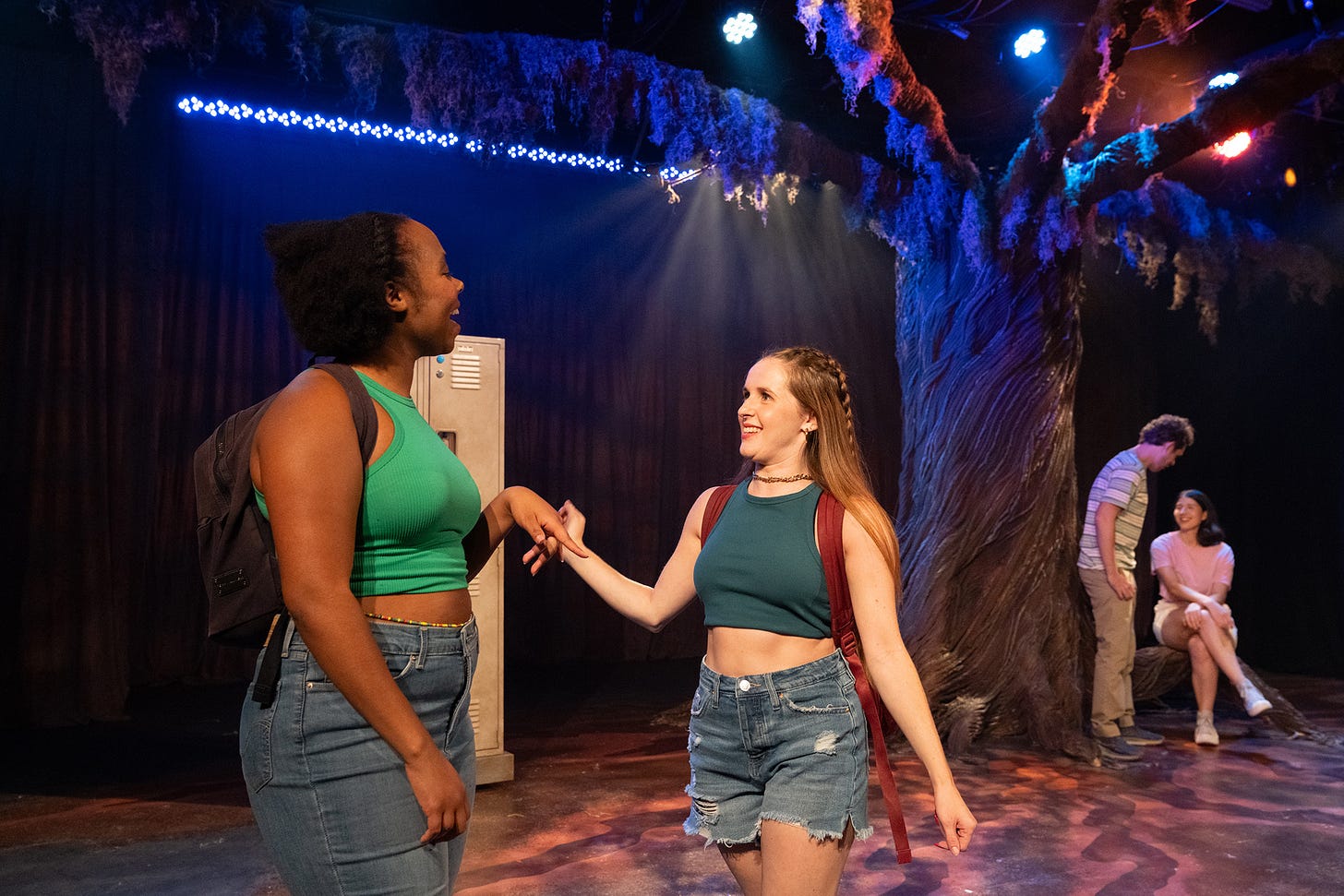Fourth walls fall: 'Life Sucks,' 'Every Brilliant Thing,' 'Measure STILL.' 'Tacos' tops LATC's trio.
Plus LTC's big new grant. Atwater's Black-teen duo. A bi duo. McCraney and phones.
Fourth walls are tumbling down. Yes, those invisible barriers between actors and audience are increasingly breached in contemporary theater.

Aaron Posner’s “Life Sucks," from Interact Theatre at the Broadwater in Hollywood, is replete with the actors’ recognition of the audience a few feet away. Although no spectator is pressured to participate, the play ends only after the cast solicits sum-it-all-up suggestions from the audience. A character named Vanya (John Ross Bowie) chooses one of the responses that sounds appropriate and then announces “end of play.”
Posner’s script is an adaptation of Chekhov’s “Uncle Vanya.” It has the contemporary and Americanized spirit of Christopher Durang’s “Vanya and Sonia and Masha and Spike,” but Durang’s self-described “blender” script draws on ingredients of other Chekhovian plays beyond “Uncle Vanya” (Pacific Resident Theatre revived it earlier this year).
“Life Sucks” is not only more concentrated on “Uncle Vanya” but also somewhat more urban — in fact, if this production is set anywhere specific, it’s probably in LA (see below for the one big clue about this). Posner refers briefly to current American celebrities. The minor character “Pickles,” replacing the original’s male “Waffles,” is an out-of-the-closet lesbian. Yet Vanya himself isn’t gay, as Durang’s Vanya is.
Posner sprinkles in a few Yiddishisms, such as tsuris — a word that perfectly fits the play’s characters. This leads to the faint suggestion that at least some of them might be Jewish, but they’re far from any Russian shtetl. Probably most of them follow up-to-the-minute news and stream movies.
Which is somewhat ironic, because in “Life Sucks,” the collapse of the fourth wall makes each performance feel like more of a collaborative creation between actors and audience — which isn’t possible with a streamed movie. We can expect more such eradications of that barrier on our stages. We’re in a period when many theater companies hope that face-to-face, in-the-moment experiences with other human beings might help lure spectators away from their pandemic-era streaming habits.
“Life Sucks” is hilarious much of the time — but the comedy comes from a deep place. Director Barry Heins’ cast delivers razor-sharp performances, not only from Bowie but from Erin Pineda (as the woman for whom all of the men pine), Steve Vinovich as her older and pompous husband and Olivia Castanho as his long-suffering daughter. And it’s a joy to see Anne Gee Byrd again assuming an older-woman role in this adaptation, as she has so frequently in earlier productions of “Vanya.” In this version, her character Babs is a wise potter.
During the introduction, Vanya offers to refund the ticket price, plus a dollar, to anyone who wants to “leave right now.” At least on opening night, Babs then suggested that “you can probably catch ‘Every Brilliant Thing’ at the Geffen Playhouse. I’ve heard really great things.” See what I meant a few paragraphs ago? This production of “Life Sucks” is set in LA (and conveniently enough, it’s scheduled to close on the same day, October 29, as “Every Brilliant Thing”).
Still, Babs didn’t hear “really great things” from me about the Geffen’s “Every Brilliant Thing.” Perhaps she had simply heard that “Thing” has even more audience interaction than “Life Sucks.”
It’s true. The number of the Geffen’s “Thing” spectators who have audible roles, thanks to cue cards which they’re handed before the performance begins, is much larger than the number of “Life Sucks” playgoers who actively participate. Also, a few “Thing” visitors are called on to enter the center arena of the Geffen’s smaller theater, where they interact briefly on their feet with the show’s one actor, Daniel K. Isaac.
The “Thing” audience is drafted into service because otherwise the script, by Duncan Macmillan with Jonny Donahoe, would be a rather predictable solo show, about a young man who learned to count his life’s small pleasures as a self-protective reaction to his worst experiences.
The production, directed by Colm Summers, feels skin-deep. Isaac too often seems like a genial game-show host, not someone who experienced any angst or loss. The audience participation creates a superficially festive party atmosphere that erases any sensation that, well, life sometimes sucks. The comedy yields polite chuckles compared to the belly laughs that emerged from me in “Life Sucks.”
By the way, “Every Brilliant Thing” first appeared locally at the Broad Stage in 2017, but with only 10 performances. I didn’t see that production, which featured a different director and co-writer Donahoe as the host/soloist, so I can’t compare “Thing” Two to “Thing” One.
Finally, any discussion about the tumbling of the fourth wall in LA right now must acknowledge writer/director Jessica Kubzansky’s “Measure STILL for Measure,” at Boston Court in Pasadena.
The first part of the event occurs throughout most of the Boston Court complex. Each member of the audience roams at will, observing the cast members playing fictional actors who are rehearsing for a production of Shakespeare’s “Measure for Measure” — or simply gossiping. After intermission, the rest of Kubzansky’s play occurs with the audience seated in the usual auditorium, but the fictional cast of “Measure for Measure” is still in rehearsals. We can STILL see what’s happening in adjacent locations — via cameras and screens.
It’s all a bit too complicated. When I started reading the script after seeing the production, I immediately discovered that some little scenes are set in the Boston Court parking lot. Because the lot had been full when I drove into it, I had left it in order to find street parking. Then, after I finally entered the building, I didn’t even think about going into the parking lot on foot, so I didn’t see any of those scenes.
The erasure of the fourth wall here is strictly immersive, not interactive in the same way that “Life Sucks” and “Every Brilliant Thing” are. That’s appropriate. This is a script that questions how to interpret the ending of Shakespeare’s play, which — in our post-Me-Too times — is quite controversial. Spoiler alert: The director of the play-within-the-play, who also is one of the actors in it, appears to be somewhat abusive, like his corresponding character in Shakespeare’s play. But the script and the format take too long before they focus on that point — or at least so it seemed in the winding paths that I chose to follow during the first part of the production.
By the way, while we’re in that neighborhood, I should acknowledge that the most recent Pasadena Playhouse production, “The Sound Inside,” which closed Sunday, did not break the fourth wall. Although Adam Rapp’s Yale-set two-person drama was described in promotional materials as “thrilling” and Times critic/Yale graduate Charles McNulty’s review used a variant on “enthralling,” I didn’t detect any thrills — nor was I in thrall to it. It might have worked better in a smaller theater — which I also noted about the four-actor “Stew” at the playhouse last summer. Both plays felt anti-climactic after the playhouse’s sensational Sondheim festival.
‘Tacos,’ anyone? With a grant on the side?
Downtown’s Latino Theater Company is glowing these days since the public announcement that it will initially administer the new National Latinx Theater Initiative, funded by $9 million so far from various foundations, to support Latinx theaters companies across the country. The directors during the initiative’s first three years (which actually started last December) will be LTC artistic director José Luis Valenzuela and Olga Garay-English, a former director of LA city’s Department of Cultural Affairs.
LTC’s city-owned home at Los Angeles Theatre Center is also bustling these days, with productions opening on successive weekends on the building’s larger stages. LTC developed and produced one of the three, the premiere of “Tacos La Brooklyn,” by Joel Ulloa, doing it “in association with East West Players.” Located in LATC’s downstairs space, it’s also the best of the three.

The heart of Ulloa’s play is a story about a mid-30s once-abused Korean-American man, nicknamed “Chino” (Gavin K. Lee), who has learned the trade of running a barbacoa stand in LA and has now taken it over from his late mentor. He sells his tacos at a downtown LA night market (no, the “Brooklyn” in the title isn’t the NYC borough) with the aid of the old man’s widow, who makes the tortillas. They’re flanked by two stands with Chicano proprietors, but the competition is generally friendly.
However, trouble arises when Yesenia (Esperanza América), a Chicana social influencer, notices Chino. She resents that this Korean guy makes his tacos with such expensive ingredients as heirloom corn. Chino is selling a lot of tacos, until Yesenia alerts her followers to request Chino to “appreciate, not appropriate.”
It’s a lively script, reflecting more than one point of view about its themes. Fidel Gomez’s staging is charged with energy, with swirling lights indicating the hyper-active phones in the night air, accompanied by thumping musical beats, but also featuring the more soulful sounds of an older singer (Jesus ‘Chuy’ Perez) and occasional English supertitles of Spanish dialogue.
The script could be organized more efficiently. The first nine pages are a bit confusing, as they focus on a real-life cross-cultural phenomenon in which young Japanese people have been influenced by cholo/chola fashion in clothes and cars. Complete with the use of Japanese supertitles, it’s an odd way to open such a hyper-local East LA play.
However, the other two LATC plays seem even more remote from what’s happening in LA in 2023. On the building’s largest stage is Luis Alfaro’s “The Travelers,” set in a withering monastery about 30 miles south of Fresno. We don’t see much of the actual building, because the design isn’t very specific, but the set and lighting are lush and inviting, which feels a bit out of place. We do meet the dispirited brothers who live there, although their backgrounds remain mostly rudimentary. Sean San José — who plays the group’s leader — restaged the play for LATC after its world premiere at San Francisco’s Magic Theatre, where he is the artistic director.
In the excessively deep space next to LATC’s entrance is Preston Choi’s “This Is Not a True Story,” which is certainly a true statement — it’s not much of a story at all. It’s a satirical sketch that belabors the obvious point that CioCio from “Madama Butterfly” and Kim from “Miss Saigon” are stereotypes of Asian women at the mercy of white Western men. So is the somewhat more obscure Kumiko (from a 2014 movie that most theater-centric people probably don’t know). Artists at Play, an Asian-American troupe, produced, at a small disadvantage because so much of the seating in the venue is so far above the action, discouraging the necessary intimacy.
By the way, the LA Times article about LTC’s leadership of the Latinx initiative somehow didn’t mention the companies in greater LA that will benefit from the initiative’s initial largesse. In alphabetical order, they include About Productions in Pasadena, Breath of Fire Latina Theater Ensemble in Santa Ana, Casa 0101 in Boyle Heights, Company of Angels in Lincoln Heights, the itinerant but LA-based Culture Clash and Sinergia Grupo de Teatro, north of MacArthur Park. The article also mentioned that LATC is currently hosting “The Travelers” but ignored the LTC-developed “Tacos La Brooklyn.”
As you might have noticed, Latino Theater Company itself is not on that list of beneficiaries. In a statement relayed to me from Valenzuela, he said that receiving funds for the company’s own productions would be a conflict of interest. But LTC is receiving an amount, estimated by LTC to be approximately $500,000 every year for three years, for administering the grants program. (Note: This is an updated figure that was provided after this post appeared).
This good news for Latino companies follows the recent funding of California’s SB1116, which re-allocates $11.5 million in unused arts funding to create a payroll fund to support small nonprofit arts organizations, including the majority of theater companies in Greater LA. Sen. Anthony Portantino of Burbank introduced the bill and Governor Newsom signed it, but it took almost a year for the approved bill to be funded.
The shows are flowing at Atwater
Speaking of that sub-100-seat theater scene, Atwater Village Theatre is almost as busy as LATC, led by two different sub-100-seat companies, presenting superb productions, side by side, of plays with leading characters who are Black teenagers — and with a few secondary reflections on homophobia.

On the south side of the complex is Dominique Morisseau’s “Blood at the Root,” produced by Open Fist Theatre. This 2014 play was inspired by real-life racial strife at a small-town high school in Louisiana in 2007. Morisseau, who also wrote the recently applauded “Pipeline,” acutely analyzes the psychology of students of both races, from different social strata within the school. Michael A. Shepperd’s propulsive, rhythmic staging drives the production along the play’s fragile tracks without derailing.
On the north side of the Atwater building is the West Coast premiere of JuCoby Johnson’s “How It’s Gon’ Be,” produced by Echo Theater Company. While all of the characters in “Blood at the Root” are students, Johnson’s play also devotes attention to the young protagonist’s parents — his strapped mother and his military father, who is largely absent from his family’s life but is very present in the play. The setting is a big city, Jacksonville, in the early 2000s. Director Ahmed Best respects the script’s more pensive mood (compared to “Blood at the Root”) by focusing on plenty of small, delicate moments as well as the larger scenes.
Echo is also producing a tantalizing Sunday-evenings-only play, “Certain Death and Other Considerations.” It’s scheduled to close on October 15, after only two more performances, so I’ll be brief. In a society much like that of US residents today, scientists say the world will end in precisely 80 years. A countdown clock over the stage reminds us of this (although it’s a little confusing because the chronology of scenes isn’t always sequential). For young couples, the question is “To procreate or not?” Playwright Eliza Frakes plays the role of a gestational surrogate.
I shouldn’t mention “Certain Death” without also mentioning India Kotis’ “Bisexual Sadness,” at the Road (but on Magnolia Boulevard) in North Hollywood, because in each play a seemingly heterosexual young woman has or had a sexual relationship with another woman. However, as the titles suggest, the underlying subject of “Certain Death” is climate change, while in “Bisexual Sadness” it’s the nature of being bisexual.
In Kotis’ play, a feminine-presenting woman is now on the verge of marrying a man — while remaining on good terms with her now nonbinary former lover Genevieve, who has a new girlfriend. Confused? Well, Kotis’ script and Carlyle King’s staging don’t try to tie everything up with a neat bow, but the package has a lot of drama, humor and — yes — a tinge of sadness.
Was this comment about phones…phony?
A recent comment by Geffen Playhouse’s new artistic director Tarell Alvin McCraney, in an interview with Charles McNulty in the LA Times, raised my eyebrows. Here is what McCraney said, in the context of attracting younger audiences:
"People are still going to concerts. But many concerts are outside. And there’s a different kind of energy there that we have to plug into. How do we do that here? We tell young people who are connected to their friends through their phones, ‘Hey, turn that off when you come in here.’ Well, if they’re turning that off, how are they going to be connected to their friends to show that they’re at a play? That’s important to them. And we’re telling them that it’s not important. You can’t tell someone who’s built their entire life in being connected in this way that they have to turn it off when you come in here. This is a conversation we need to enter into.”
OK, I’ll enter the conversation. I don’t know of any theater that requires audience members to turn off their phone when they enter the building. Indeed, many theaters nowadays erect splashy backdrops in the lobby that are specifically designed for the purpose of taking photos and video, before the show starts and perhaps after it ends, to help spread the word about the production on social media.
No, the messages about turning off phones apply only to the time spent during the actual performance. This isn’t only to guard against potentially pirated video or other legal issues. More important to me is the fact that lighted phones distract me and other theatergoers from concentrating on the production. Sure, there are a couple of productions that have actively encouraged telephone use at some point during the show (“Six” comes to mind), but fortunately this hasn’t spread far.
After I asked what this comment might mean, a Geffen spokesman replied that the theater’s own policy hasn’t changed — spectators will still be told to turn off their phones during the shows. Many productions pay for carefully crafted video as part of the production design, but no one should encourage playgoers to use their phones for their private social-influencing or, even worse, for texted or spoken conversations during a performance. Opening the fourth wall has its limits.


